Penedo Do Gato Rock Art Shelter (Monterrei, NW Iberian Peninsula): In Situ and Laboratory Characterisation
Abstract
1. Introduction
2. The Rock Art Shelter at the Penedo Do Gato Site (Monterrei, NW Iberian Peninsula)
2.1. Historical Precedents
2.2. Localisation and Context
3. Analytical Protocol
3.1. In Situ Characterisation
3.2. Sampling
- -
- A dark reddish stone (ID 300).
- -
- A grey stone with bright yellow-orange-coloured deposits (ID 698).
- -
- A grey stone with a light reddish coloured deposit (ID 705).
| ID 300 | ID 698 | ID 705 |
|---|---|---|
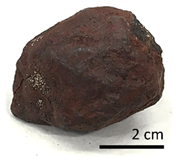 | 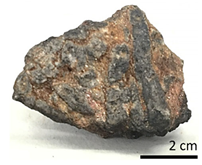 |  |
| C-LOB19 PSS 0300 | C-LOB19 PSN 0698 | C-LOB19 PSN 0705 |
| SECTOR 2. South. Surface | SECTOR 1. Surface | SECTOR 1 Surface |
3.3. Laboratory Characterisation
- The mineralogical composition of all three samples was determined by X-ray diffraction (XRD, Siemens D5000, München, Germany), applying the random powder method. Powder was scraped off the surface using a punch. Samples were ground in a mechanical ball mill. Analyses were performed using Cu-Kα radiation, Ni filter, 45 kV voltage, and 40 mA intensity. The exploration range was 3° to 60° 2θ, and the goniometer speed was 0.05° 2θ s−1.
- Samples were then embedded in an epoxy resin (EpoThin 2 Epoxy Resin and EpoThin 2 Epoxy Hardener). Once hard, a transversal cut was made to obtain specimens measuring 2 cm × 2 cm × 1 cm. These cross-sections were visualised by stereomicroscopy (SMZ800 NIKON®, Tokyo, Japan).
- Lastly, the cross-sections were coated using carbon, and they were visualised using scanning electron microscopy with energy dispersive X-ray spectroscopy (SEM-EDX) in backscattered (BSE) and secondary (SE) electrons modes using a FEI Quanta 200. Optimum conditions of observation were obtained for an accelerating potential of 20 kV, a working distance of 9–11 mm, and a specimen current of ca. 60 mA.
4. Results and Discussion
4.1. Penedo Do Gato Paintings
4.2. In Situ Characterisation
4.3. Laboratory Characterisation
5. Conclusions
Author Contributions
Funding
Data Availability Statement
Acknowledgments
Conflicts of Interest
References
- Saiz-Jimenez, C.; Cuezva, S.; Jurado, V.; Fernandez-Cortes, A.; Porca, E.; Benavente, D.; Sánchez-Moral, S. Paleolithic art in peril: Policy and science collide at altamira cave. Science 2011, 334, 42–43. [Google Scholar] [CrossRef] [PubMed]
- Morillas, H.; Maguregui, M.; Bastante, J.; Huallparimachi, G.; Marcaida, I.; García-Florentino, C.; Astete, F.; Madariaga, J.M. Characterization of the Inkaterra rock shelter paintings exposed to tropical climate (Machupicchu, Peru). Microchem. J. 2018, 137, 422–428. [Google Scholar] [CrossRef]
- Huntley, J.; Aubert, M.; Oktaviana, A.A.; Lebe, R.; Hakim, B.; Burhan, B.L.; Muhammad Aksa, L.; Made Geria, I.; Ramli, M.; Siagian, L.; et al. The effects of climate change on the Pleistocene rock art of Sulawesi. Sci. Rep. 2021, 11, 9833. [Google Scholar] [CrossRef] [PubMed]
- Gallinaro, M.; Zerboni, A. Rock, pigments, and weathering. A preliminary assessment of the challenges and potential of physical and biochemical studies on rock art from southern Ethiopia. Quat. Int. 2021, 572, 41–51. [Google Scholar] [CrossRef]
- Zerboni, A.; Villa, F.; Wu, Y.L.; Solomon, T.; Trentini, A.; Rizzi, A.; Cappitelli, F.; Gallinaro, M. The Sustainability of Rock Art: Preservation and Research. Sustainability 2022, 14, 6305. [Google Scholar] [CrossRef]
- Seawards, M.R.D. Lichens as Agents of Biodeterioration. In Recent Advances in Lichenology; Upreti, D.K., Divakar, P.K., Shykla, V., Bajpai, R., Eds.; Springer: New Delhi, India, 2015; pp. 189–211. [Google Scholar]
- Tratebas, A.M. Biodeterioration of prehistoric rock art and issues in site preservation. In Biodeterioration of Stone Surfaces: Lichens and Biofilms as Weathering Agents of Rocks and Cultural Heritage, 1st ed.; St. Clair, L.L., Seaward, M.R.D., Eds.; Springer: Dordrecht, The Netherlands, 2004; pp. 195–228. [Google Scholar]
- Taçon, P.S.C. Graffiti, Vandalism and Destruction: Preserving Rock Art in a Globalized World. In Time Images in the Age of Globalization. Interdisciplinary Contributions to Archaeology; Abadía, O.M., Conkey, M.W., McDonald, J., Eds.; Springer: Lisbon, Portugal, 2024; pp. 245–255. [Google Scholar]
- Bednarik, R.G. More on rock art removal. S. Afr. Archaeol. Bull. 2008, 63, 82–84. [Google Scholar]
- Yates, D.; Bērziņa, D.; Wright, A. Protecting a Broken Window: Vandalism and Security at Rural Rock Art Sites. Prof. Geogr. 2022, 74, 384–390. [Google Scholar] [CrossRef]
- Brecoulaki, H.; Verri, G.; Kalaitzi, M.; Maniatis, Y.; Lilimpaki-Akamati, M. Investigating Colors and Techniques on the Wall Paintings of the ‘Tomb of the Philosophers’, an Early Hellenistic Macedonian Monumental Cist Tomb in Pella (Macedonia, Greece). Heritage 2023, 6, 5619–5647. [Google Scholar] [CrossRef]
- Dilaria, S.; Sbrolli, C.; Mosimann, F.S.; Favero, A.; Secco, M.; Santello, L.; Salvadori, M. Production technique and mul-ti-analytical characterization of a paint-plastered ceiling from the Late Antique villa of Negrar (Verona, Italy). Archaeol. Anthropol. Sci. 2024, 16, 1–21. [Google Scholar] [CrossRef]
- Mazzocchin, G.A.; Agnoli, F.; Mazzocchin, S.; Colpo, I. Analysis of pigments from Roman wall paintings found in Vicenza. Talanta 2003, 61, 565–572. [Google Scholar] [CrossRef]
- Pozo-Antonio, J.S.; Comendador, B.; Alves, L.B.; Barreiro, P. Methodological approach (in situ and laboratory) for the characterisation of late prehistoric rock paintings—Penedo Gordo (NW Spain). Minerals 2021, 11, 551. [Google Scholar] [CrossRef]
- Rosina, P.; Collado, H.; Garcês, S.; Gomes, H.; Eftekhari, N.; Nicoli, M.; Vaccaro, C. Benquerencia (La Serena—Spain) rock art: An integrated spectroscopy analysis with FTIR and Raman. Heliyon 2019, 5, e02561. [Google Scholar] [CrossRef] [PubMed]
- Iriarte, M.; Hernanz, A.; Gavira-Vallejo, J.M.; Alcolea-González, J.; de Balbín-Behrmann, R. μ-Raman spectroscopy of prehistoric paintings from the El Reno cave (Valdesotos, Guadalajara, Spain). J. Archaeol. Sci. Rep. 2017, 14, 454–460. [Google Scholar] [CrossRef]
- Prinsloo, L.C.; Tournié, A.; Colomban, P.; Paris, C.; Bassett, S.T. In search of the optimum Raman/IR signatures of potential ingredients used in San/Bushman rock art paint. J. Archaeol. Sci. 2013, 40, 2981–2990. [Google Scholar] [CrossRef]
- Kubik, M.E. Preserving the Painted Image: The Art and Science of Conservation. J. Int. Colour Assoc. 2010, 5, 1–8. [Google Scholar]
- Sanmartín, P.; Vázquez-Nion, D.; Silva, B.; Prieto, B. Spectrophotometric color measurement for early detection and monitoring of greening on granite buildings. Biofouling 2012, 28, 329–338. [Google Scholar] [CrossRef]
- Días, L.; Rosado, T.; Candeias, A.; Mirão, J.; Caldeira, A.T. A change in composition, a change in colour: The case of limestone sculptures from the Portuguese National Museum of Ancient Art. J. Cult. Herit. 2020, 42, 255–262. [Google Scholar] [CrossRef]
- Alves, L.B.; Comendador Rey, B. Arte esquemático pintado en el noroeste peninsular: Una visión integrada transfronteriza. Gallaecia Rev. De Arqueol. E Antigüidade 2018, 36, 11–52. [Google Scholar] [CrossRef]
- Rodríguez Rellán, C.; Fábregas Valcarce, R.; Carrera Ramírez, F. Archaeological excavation of Cova dos Mouros rock-shelter (Baleira, Lugo). A first example of schematic paint in Galicia. Munibe Antropol.-Arkeol. 2019, 70, 185–205. [Google Scholar] [CrossRef]
- Tejerizo-García, C.; Toucido, F.A.; Panizo, L.M.; Rodríguez-González, C.; Fernández-Pereiro, M.; Gutiérrez, A.R. Hallazgo de un conjunto de pintura esquemática prehistórica en el sitio de Pala de Cabras, en Casaio (Orense). PH Boletín Del Inst. Andal. Del Patrim. Histórico 2020, 100, 38–56. [Google Scholar] [CrossRef]
- Santos-Estevez, M.; Tejerizo-García, C.; Toucido, F.A. El abrigo con pintura esquemática de Pala de Cabras (Ou-rense). Encuentros y desencuentros entre dos tradiciones. Complutum 2020, 31, 7–24. [Google Scholar] [CrossRef]
- Alves, L.B.; Comendador Rey, B. Reshaping (all kinds of) borders. The site of Penedo Gordo in the context of northwestern Iberia schematic art. In Romper Fronteiras, Atravessar Territórios. Breaking Borders, Crossing Territories; Sanches, M.J., Barbosa, M.H., Teixeira, J.C., Eds.; CITCEM—Centro de Investigação Transdisciplinar Cultura, Espaço e Memória: Porto, Portugal, 2022; Volume 1, pp. 209–234. [Google Scholar] [CrossRef]
- Martínez García, J. Artes Esquemáticos de las sociedades Agrafas en la prehistoria reciente ibérica. In Rupestre. Los Primeros Santuarios. Arte Prehistórico en Alicante; Soler Díaz, J., Pérez Jiménez, R., Barciela González, V., Eds.; MARQ Museo Arqueológico de Alicante: Alicante, Spain, 2018; pp. 153–163. [Google Scholar]
- Bueno Ramírez, P.; De Balbin-Behrmann, R.; Bermejo, R.B. Megalithic art in the Iberian Peninsula Thinking About Graphic Discourses in the European Megaliths; Bailly, M., Brochier, J.E., Slimak, L., Eds.; Préhistoires Méditerranéennes, Colloque; Presses Universitaires de Provence: Aix-En-Provence, France, 2016; pp. 185–203. [Google Scholar]
- Bueno Ramírez, P.; Barroso Bermejo, R.; Balbín Behrmann, D.E. Breaking the Borders of the Mediterranean Neolithic Schematic Art in Iberian Megaliths. In Romper Fronteiras. Atravessar Territorios; Sanches, M.J., Barbosa, M.H., Teixeira, J.C., Eds.; CITCEM—Centro de Investigação Transdisciplinar Cultura, Espaço e Memória: Porto, Portugal, 2022; pp. 171–207. [Google Scholar]
- Alves, L.B. On identity and otherness. Reshaping the dynamics of the Late Prehistoric art traditions in northern Portugal. In Between the 3rd and the 2nd Millennia BC: Exploring Cultural Diversity and Change in Late Prehistoric Communities; Lopes, S., Gomes, S.A., Eds.; ArchaeoPress: Oxford, UK, 2021; pp. 49–65. [Google Scholar]
- Rodríguez-Álvarez, L.; Comendador Rey, B.; Cubas Morena, M. Prehistoric materials from A Ceada das Chás/Castelo de Lobarzán: An approach from the pottery assemblage and its decorative patterns. Sautuola Revista Del Instituto de Prehistoria y Arqueol. Sautuola 2021, 26, 41–65. [Google Scholar]
- Rodríguez-Álvarez, L.; Comendador Rey, B. Modelo de ocupación en el valle del río Támega transfronterizo en la Prehistoria Reciente: El caso de A Ceada das Chás/Castelo de Lobarzán (Oimbra/Monterrei). In Proceedings of the Actas Colóquio Internacional Romper Fronteiras, Atravessar Territorios. Identidades e Intercambios durante a Préhistória recente no interior norte da Península Ibérica, Faculdade de Letras da Universidade do Porto, Porto, Portugal, 23–24 September 2021. [Google Scholar]
- Nuño Ortea, C.; López García, M.J.; Ferragne, A.; Ruíz García, C. Mapa Geológico 1: 50.000 y Memoria Explicativa de la Hoja no 303 (8–13, Verín), 1st ed.; Segunda Serie; Publicaciones Del IGME: Madrid, Spain, 1981. [Google Scholar]
- Vaqueiro, M. Topography and Morphology of the Cova das Pinturas de Lobarzán: Report on the Topographic Work Carried Out by CETRA, Unpublished Manuscript. 2019; COmplementary Video. Available online: https://vimeo.com/409165261 (accessed on 13 May 2025).
- Comendador Rey, B.P.; Vilas Estévez, B.; Mouriño Schick, A.; De Uña Alvarez, E.P. PreMedia1. Creación dunha contorna virtual para a interpretación patrimonial de sitios con pintura rupestre esquemática da comarca de Monterrei. In Proxectos INOU 2020: Investigación Aplicada na Provincia de Ourense, Vigo, Spain; De Blas Varela, E., Ed.; Vicerreitoría do Campus de Ourense, Universidade de Vigo: Vigo, Spain, 2021; pp. 9–34. [Google Scholar]
- CIE S014-4/E:2007; Colorimetry-Part 4: CIE 1976 L* a* b* Colour Space. International Standard, CIE Central Bureau: Vienna, Austria, 2007.
- Jorge, S.O. Povoados da Pré-história Recente da região de Chaves-Vila Pouca de Aguiar (Trás-os-Montes Ocidental): Bases para o Conhecimento do III e Princípios do II Milénios a. C. no Norte de Portugal. Doctoral Dissertation, University of Porto, Porto, Portugal, 1986. [Google Scholar]
- Collado Giraldo, H.; García Arranz, J.J.; Aguilar Gómez, J.C. Corpus de arte Rupestre en Extremadura. Vol. II: Arte Rupestre en La Zepa de La Serena; Consejería de Cultura y Patrimonio de la Junta de Extremadura: Badajoz, Spain, 2018. [Google Scholar]
- Collado Giraldo, H. Propuesta para la clasificación funcional y cronológica del arte rupestre esquemático a partir del modelo extremeño. In Estudios de Prehistoria y Arqueología en Homenaje a Pilar Acosta Martínez; Auñón, R., Cruz, F., Ferrer Albelda, E., Eds.; Universidad de Sevilla: Seville, Spain, 2009; pp. 89–108. [Google Scholar]
- Cerrillo Cuenca, E. Los Barruecos: Primeros Resultados Sobre el Poblamiento Neolítico de la Cuenca Extremeña del Tajo; Dirección General de Patrimonio Cultural, Junta de Extremadura: Mérida, Spain, 2006. [Google Scholar]
- Zapatero, P.; Guerra, E. Painting the Neolithic landscape of the Amblés Valley: Schematic Art, landmarks and symbolic territories of Central Iberia. In Neolithic and Bronze Age Studies in Europe. From Material Cultures to Territories; Besse, M., Giligny, F., Eds.; Archaeopress: Oxford, UK; Cambridge, UK, 2021; pp. 66–77. [Google Scholar]
- Guerra Doce, E.; Zapatero Magdaleno, M.P.; Delibes De Castro, G.; García Cuesta, J.L.; Fabián García, J.F.; Riquelme Cantal, J.A.; López Sáez, J.A. Herders and Pioneers: The Role of Pastoralism in the Neolithization of the Amblés Valley (Ávila, Central Iberia). Open Archaeol. 2021, 7, 1550–1563. [Google Scholar] [CrossRef]
- González, A. El papel de las cazoletas como parte de un código común. In XXVII Coloquios Histórico-Culturales del Campo Arañuelo; Gonzalez Cordero, A., Ed.; Ayuntamiento de Navalmoral de la Mata: Navalmoral de La Mata, Spain, 2022; pp. 245–299. [Google Scholar]
- Gómez, M. La pintura rupestre esquemática como acción social de los grupos agroganaderos en la meseta castellanoleonesa. Cuad. De Arte Rupestre 2005, 2, 11–58. [Google Scholar]
- Bradley, R.; Fábregas, R.; Alves, L.; Vilaseco, X. El Pedroso–A prehistoric cave sanctuary in Castille. J. Iber. Archaeol. 2005, 7, 1–7. [Google Scholar]
- Collado Giraldo, H.; García Arranz, J.J. Pintura rupestre esquemática sobre granito en la provincia de Cáceres: Los ejemplos de la cueva larda del Pradillo y los Canchalejos de Belén (Trujillo). Zephyrus 2009, 64, 19–38. [Google Scholar]
- González, A.; Cerrillo, E. Relación Espacial y Contextualización del arte Esquemático: Dos Nuevos Ejemplos en la Provincia de Cáceres: Poblado de la Canchalera del Moro (Jarilla) y Sepulcro de la Cueva del Moro (Aldea del Cano); Martínez García, J., Hernández Pérez, M., Eds.; Actas del Congreso de Arte Esquemático en la Península Ibérica: Almería, Spain, 2006; pp. 235–248. [Google Scholar]
- Carrera Ramírez, F. La conservación preventiva del dolmen de Dombate: Un modelo para la gestión del patrimonio megalítico. Patrim. Cult. De España 2013, 7, 120–123. [Google Scholar]
- Carrera Ramírez, F.; Vilaseco Vázquez, J. Estudio, Conservación y Difusión del Arte Megalítico Gallego: El Caso de Dombate; Arte y Arquitectura Megalítica en Europa; Xunta de Galicia: Santiago de Compostela, Spain, 2014; pp. 105–112. [Google Scholar]
- Pereira-Martínez, X. Espazos de Moenda e de Representación na Prehistoria Recente e Protohistoria do Miño Litoral (Noroeste Ibérico). Doctoral Dissertation, University of Santiago de Compostela, Santiago de Compostela, Spain, 2023. [Google Scholar]
- Mokrzycki, W.; Tatol, M. Color difference Delta E-A survey Colour difference ∆E-A survey. Mach. Graph. Vis. 2011, 20, 383–411. [Google Scholar]
- Burgio, L.; Clark, R.J.H. Library of FT-Raman spectra of pigments, minerals, pigment media and varnishes, and supplement to existing library of Raman spectra of pigments with visible excitation. Spectrochim. Acta A Mol. Biomol. Spectrosc. 2001, 75, 1491–1521. [Google Scholar] [CrossRef]
- Pan, A.; Rebollar, E.; Chiussi, S.; Serra, J.; González, P.; León, B. Optimisation of Raman analysis of walnut oil used as protective coating of Galician granite monuments. J. Raman Spectrosc. 2010, 41, 1159–1164. [Google Scholar] [CrossRef]
- Wang, A.; Valentine, R.B. Seeking and Identifying Phyllosilicates on Mars. A simulation study. In Proceedings of the 33rd Annual Lunar and Planetary Science Conference, South Shore Harbour Resort and Conference Center, Houston, TA, USA, 11–15 March 2002, abstract nº 1370. ISSN 0161-5297. [Google Scholar]
- Wang, A.; Freeman, J.; Kuebler, K.E. Raman Spectroscopic Characterization of Phyllosilicates. In Proceedings of the 33rd Annual Lunar and Planetary Science Conference, South Shore Harbour Resort and Conference Center, Houston, TA, USA, 11–15 March 2002, abstract nº 1374. ISSN 0161-5297. [Google Scholar]
- Hernández, A.C.; Sanjurjo-Sánchez, J.; Alves, C.; Figueiredo, C.A.M. Provenance Studies of Natural Stones Used in Historical Buildings of the Peninsula de Barbanza, Galicia, Spain (North-Western Iberia). Minerals 2024, 14, 595. [Google Scholar] [CrossRef]
- Iriarte, M.; Hernanz, A.; Ruiz-Lõpez, J.F.; Martín, S. μ-Raman spectroscopy of prehistoric paintings from the Abrigo Remacha rock shelter (Villaseca, Segovia, Spain). J. Raman Spectrosc. 2013, 44, 1557–1562. [Google Scholar] [CrossRef]
- Hernanz, A.; Ruiz-López, J.F.; Madariaga, J.M.; Gavrilenko, E.; Maguregui, M.; De Vallejuelo, S.F.O.; Martínez-Arkarazo, I.; Alloza-Izquierdo, R.; Baldellou-Martínez, C.; Viñas-Vallverdú, R.; et al. Spectroscopic characterisation of crusts interstratified with prehistoric paintings preserved in open-air rock art shelters. J. Raman Spectrosc. 2014, 45, 1236–1243. [Google Scholar] [CrossRef]
- Rosina, P.; Gomes, H.; Collado, H.; Nicoli, M.; Volpe, L.; Vaccaro, C. Μicro-Raman spectroscopy for the characterization of rock-art pigments from Abrigo del Águila (Badajoz—Spain). Opt. Laser Technol. 2018, 102, 274–281. [Google Scholar] [CrossRef]
- Marshall, C.P.; Dufresne, W.J.B.; Rufledt, C.J. Polarized Raman spectra of hematite and assignment of external modes. J. Raman Spectrosc. 2020, 51, 1522–1529. [Google Scholar] [CrossRef]
- Wang, L.; Zhu, J.; Yan, Y.; Xie, Y.; Wang, C. Micro-structural characterization of red decorations of red and green color porcelain (Honglvcai) in China. J. Raman Spectrosc. 2009, 40, 998–1003. [Google Scholar] [CrossRef]
- Chernyshova, I.V.; Hochella, M.F.; Madden, A.S. Size-dependent structural transformations of hematite nanoparticles. 1. Phase transition. Phys. Chem. Chem. Phys. 2007, 9, 1736–1750. [Google Scholar] [CrossRef]
- Lofrumento, C.; Ricci, M.; Bachechi, L.; De Feo, D.; Castellucci, E.M. The first spectroscopic analysis of Ethiopian prehistoric rock painting. J. Raman Spectrosc. 2012, 43, 809–816. [Google Scholar] [CrossRef]
- Edwards, H.G.M.; Newton, E.M.; Russ, J. Raman spectroscopic analysis of pigments and substrata in prehistoric rock art. J. Mol. Struct. 2000, 550–551, 245–256. [Google Scholar] [CrossRef]
- Edwards, H.G.M.; Farwell, D.W.; Perez, F.R.; Garcia, J.M. Mediaeval cantorals in the Valladolid Biblioteca: FT-Raman spectroscopic study. Analyst 2001, 126, 383–388. [Google Scholar] [CrossRef]
- do Carmo Serrano, M.; Lopes, A.C.; Seruya, A.I. Plantas tintureiras. Rev. De Ciências Agrárias 2008, 31, 3–21. [Google Scholar]
- Vandenabeele, P.; Wehling, B.; Moens, L.; Edwards, H.G.M.; De Reu, M.; Van Hooydonk, G. Analysis with micro-Raman spectroscopy of natural organic binding media and varnishes used in art. Anal. Chim. Acta 2000, 407, 261–274. [Google Scholar] [CrossRef]
- Hernanz, A.; Gavira-Vallejo, J.M.; Ruiz-López, J.F. Calcium oxalates and prehistoric paintings. The usefulness of these biomaterials. J. Optoelectron. Adv. Mater. 2007, 9, 512–521. [Google Scholar]
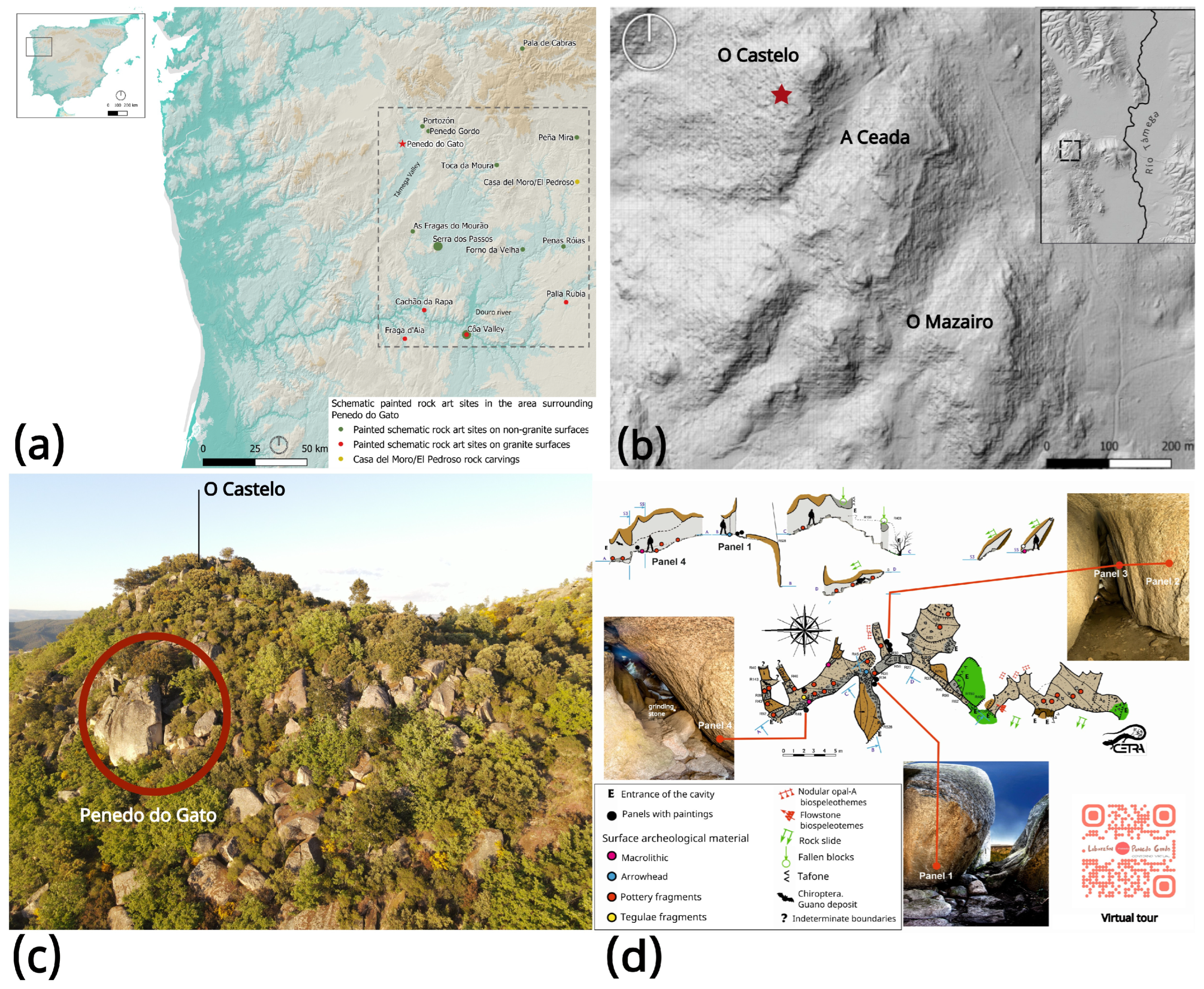
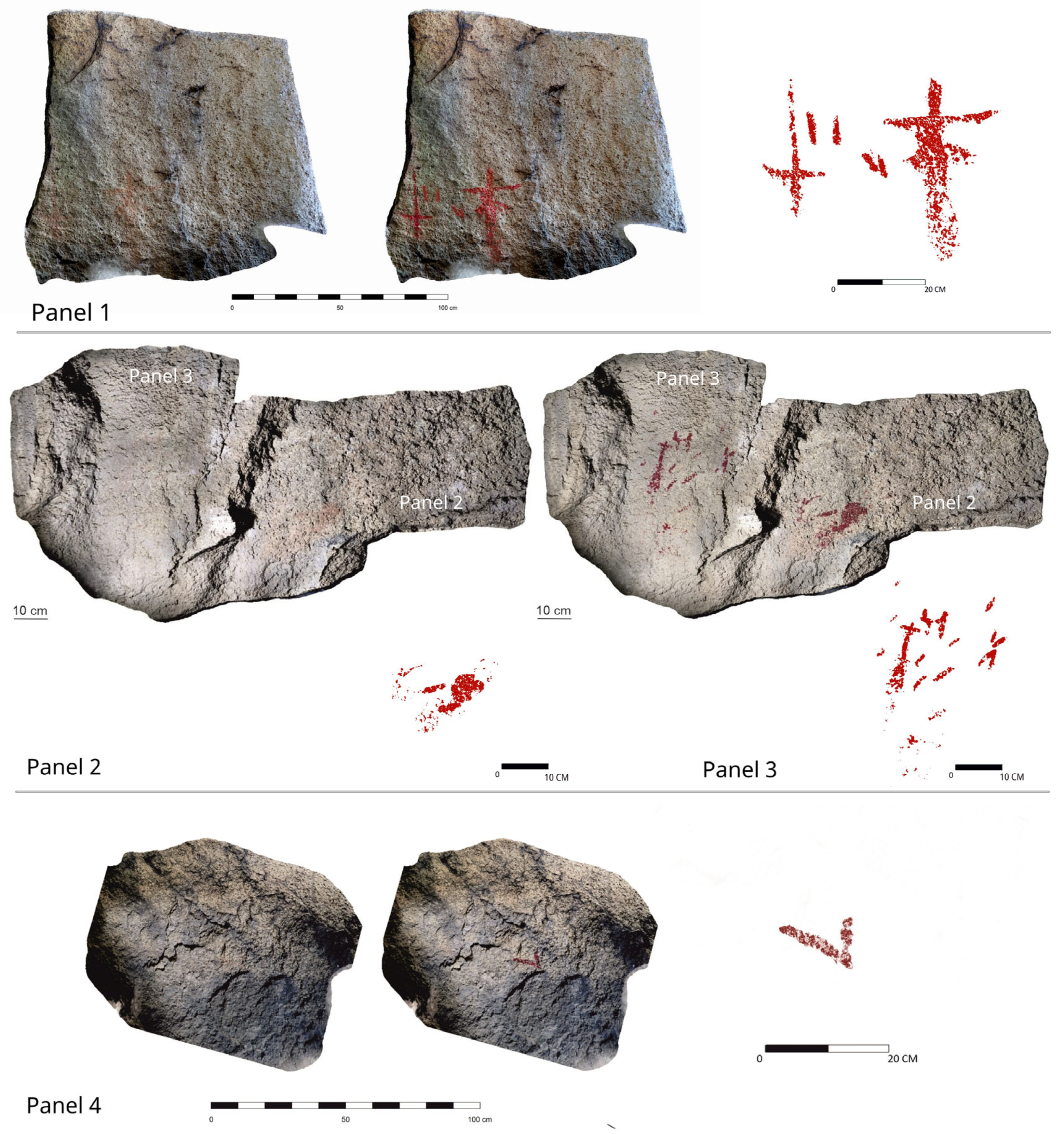
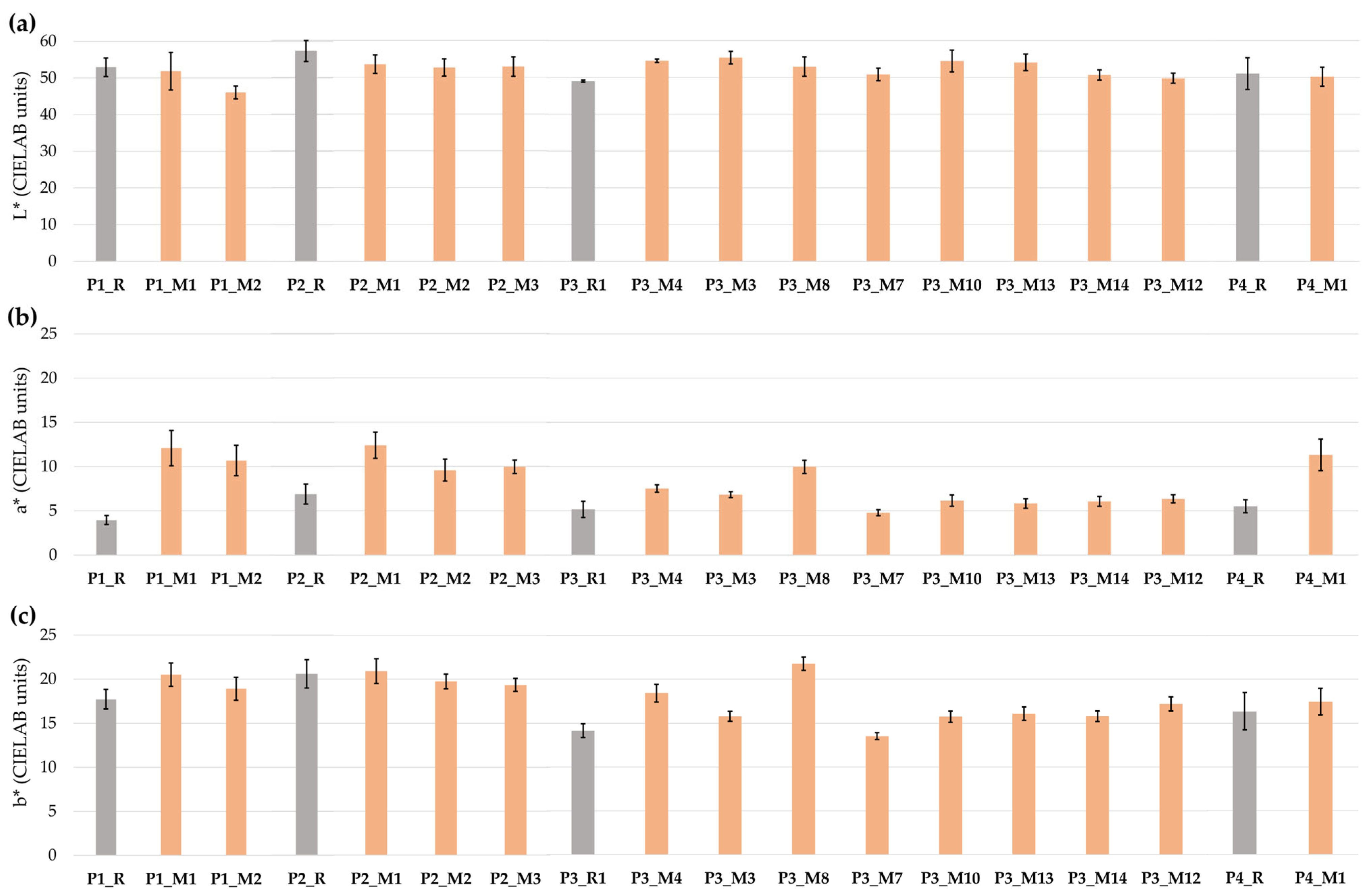


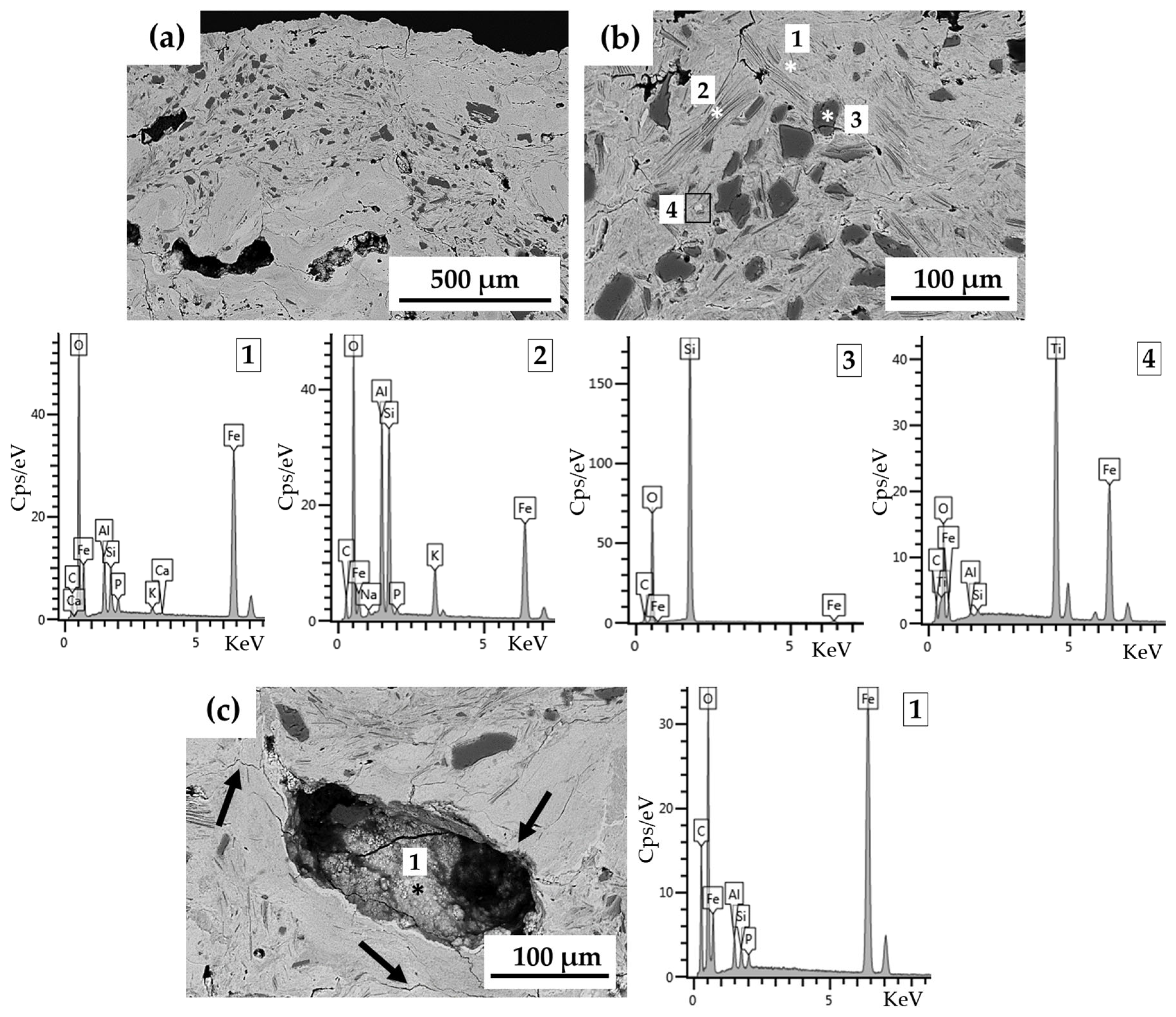

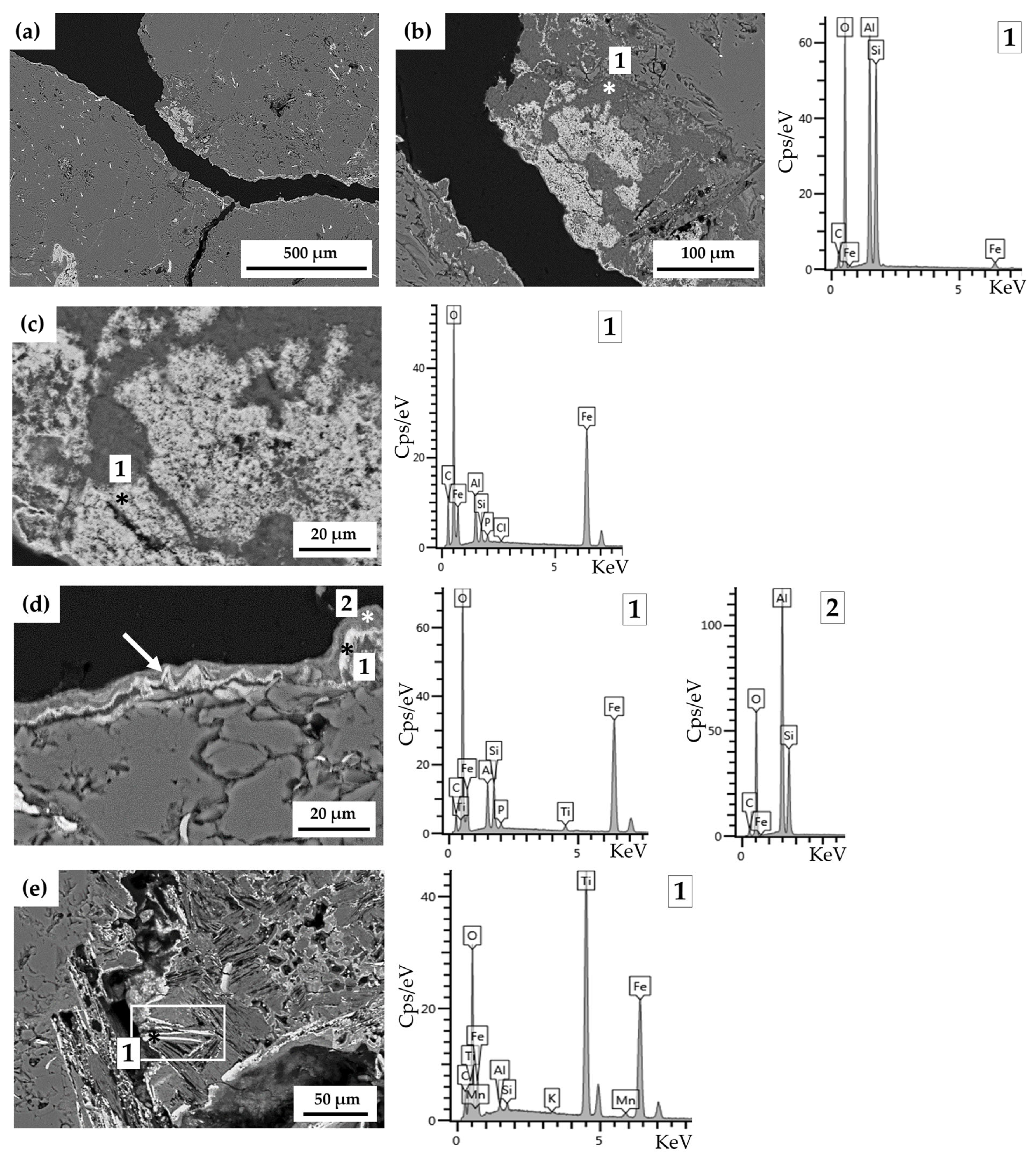
| Panel | Description | Motif |
|---|---|---|
| Panel 1 | P1-M1: Semi-schematic anthropomorphic figure with broad strokes. Cruciform shape with extended arms and legs in an inverted “V”. The lower half is less distinct, showing a phallic symbol and an oblique stroke that may represent a weapon. 25 × 25 cm. P1-M2: Highly schematic anthropomorphic figure, resembling the cruciform type. 30 × 20 cm. P1-M3 to P1-M6: Four smaller vertical motifs. |  |
| Panel 2 | P2-M1 to P2-M3: Three horizontal elements, possibly part of a larger figure. P2-M1 is an oval red stain, followed by two horizontal bars (P2-M2, P2-M3) aligned with a thicker stroke. P2-M4: Four lighter-coloured dots. P2-M5 to P2-M8: Finer strokes, oblique lines, and small dots made with a finer instrument and lighter pigment. |  |
| Panel 3 | P3-M1: Oblique bar inclined to the right. P3-M2: Oblique bar inclined to the right. P3-M3: Two vertical bars connected by a horizontal stroke. It could form part of a single figure with P3-M4. P3-M4: Cruciform motif. It could form part of a single figure with P3-M3. P3-M5: Oblique bar inclined to the right. P3-M6: Set of three digitations. P3-M7: Oblique bar inclined to the right. P3-M8: Cruciform motif, representing a very simple human figure. P3-M9: Oblique bar inclined to the right. P3-M10: Oblique bar inclined to the right. P3-M11: Oblique bar inclined to the right. P3-M12: Cruciform motif. P3-M13: Oblique bar inclined to the right. P3-M14: Oblique bar inclined to the right. P3-M15: Vertical bar, slightly oblique and inclined to the right, with a pigment lighter in colour than the previous ones. P3-M16: Oblique bar inclined to the right. P3-M17: Cruciform motif, with a pigment lighter than the previous ones. | 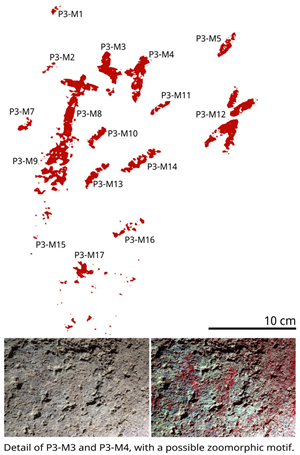 |
| Panel 4 | P4-M1. Angular stroke 12 × 8 cm. |  |
| Motif | ΔL* | Δa* | Δb* | ΔC*ab | ΔH* | ΔE*ab |
|---|---|---|---|---|---|---|
| P1-M1 | −1.07 | 8.14 | 2.79 | 5.68 | −6.44 | 8.67 |
| P1-M2 | −6.84 | 6.73 | 1.18 | 3.59 | −5.79 | 9.67 |
| P2-M1 | −3.59 | 5.51 | 0.31 | 2.60 | −4.88 | 6.58 |
| P2-M2 | −4.46 | 2.70 | −0.87 | 0.22 | −2.83 | 5.29 |
| P2-M3 | −4.22 | 3.09 | −1.27 | 0.04 | −3.37 | 5.38 |
| P3-M3 | 6.36 | 1.65 | 1.08 | 1.64 | −1.11 | 6.65 |
| P3-M4 | 5.51 | 2.34 | 3.64 | 4.26 | −0.77 | 7.01 |
| P3-M7 | 1.79 | −0.38 | −0.52 | −0.63 | 0.13 | 1.90 |
| P3-M8 | 4.66 | 0.89 | −0.29 | 0.08 | −0.96 | 4.75 |
| P3-M10 | 5.44 | 0.98 | 1.33 | 1.60 | −0.42 | 5.68 |
| P3-M12 | 0.75 | 1.18 | 2.81 | 3.04 | −0.11 | 3.14 |
| P3-M13 | 5.07 | 0.67 | 0.43 | 1.95 | 0.00 | 5.13 |
| P3-M14 | 1.67 | 0.89 | 1.43 | 1.66 | −0.32 | 2.37 |
| P4-M1 | −0.82 | 5.81 | 1.09 | 3.55 | −4.67 | 5.97 |
| Mineral | Mineralogical Formula | Samples | ||
|---|---|---|---|---|
| 300 | 698 | 705 | ||
| Quartz | SiO2 | * | * | * |
| Muscovite | KAl2(AlSi3O10)(OH)2 | * | * | * |
| Andalusite | Al2SiO5 | - | * | * |
| Ephesite | NaLiAl2(Al2Si2)O10(OH)2 | - | * | - |
| Rutile | TiO2 | - | - | * |
| Illite | (K,H3O)(Al, Mg, Fe)2(Si, Al)4O10 | - | * | - |
| Kaolinite | Al2 Si2O5(OH)4 | - | - | * |
| Microcline | KAlSi3O8 | - | * | * |
| Albite | NaAlSi3O8 | - | - | * |
| Hematite | α-Fe2O3 | * | - | * |
Disclaimer/Publisher’s Note: The statements, opinions and data contained in all publications are solely those of the individual author(s) and contributor(s) and not of MDPI and/or the editor(s). MDPI and/or the editor(s) disclaim responsibility for any injury to people or property resulting from any ideas, methods, instructions or products referred to in the content. |
© 2025 by the authors. Licensee MDPI, Basel, Switzerland. This article is an open access article distributed under the terms and conditions of the Creative Commons Attribution (CC BY) license (https://creativecommons.org/licenses/by/4.0/).
Share and Cite
Pozo-Antonio, J.S.; Comendador-Rey, B.P.; Rodríguez-Álvarez, L.; Barreiro, P.; Jiménez-Desmond, D.J. Penedo Do Gato Rock Art Shelter (Monterrei, NW Iberian Peninsula): In Situ and Laboratory Characterisation. Heritage 2025, 8, 176. https://doi.org/10.3390/heritage8050176
Pozo-Antonio JS, Comendador-Rey BP, Rodríguez-Álvarez L, Barreiro P, Jiménez-Desmond DJ. Penedo Do Gato Rock Art Shelter (Monterrei, NW Iberian Peninsula): In Situ and Laboratory Characterisation. Heritage. 2025; 8(5):176. https://doi.org/10.3390/heritage8050176
Chicago/Turabian StylePozo-Antonio, José S., Beatriz P. Comendador-Rey, Lucía Rodríguez-Álvarez, Pablo Barreiro, and Daniel J. Jiménez-Desmond. 2025. "Penedo Do Gato Rock Art Shelter (Monterrei, NW Iberian Peninsula): In Situ and Laboratory Characterisation" Heritage 8, no. 5: 176. https://doi.org/10.3390/heritage8050176
APA StylePozo-Antonio, J. S., Comendador-Rey, B. P., Rodríguez-Álvarez, L., Barreiro, P., & Jiménez-Desmond, D. J. (2025). Penedo Do Gato Rock Art Shelter (Monterrei, NW Iberian Peninsula): In Situ and Laboratory Characterisation. Heritage, 8(5), 176. https://doi.org/10.3390/heritage8050176








